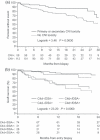Challenges and considerations in diagnosing the kidney disease in deteriorating graft function
- PMID: 22738034
- PMCID: PMC3487178
- DOI: 10.1111/j.1432-2277.2012.01516.x
Challenges and considerations in diagnosing the kidney disease in deteriorating graft function
Abstract
Despite significant reductions in acute-rejection rates with the introduction of calcineurin inhibitor (CNI)-based immunosuppressive therapy, improvements in long-term graft survival in renal transplantation have been mixed. Improving long-term graft survival continues to present a major challenge in the management of kidney-transplant patients. CNIs are a key component of immunosuppressive therapy, and chronic CNI toxicity has been widely thought to be a major factor in late graft failure. However, recent studies examining the causes of late graft failure in detail have challenged this view, highlighting the importance of antibody-mediated rejection and other factors. In addition, the diagnosis of CNI nephrotoxicity represents a challenge to clinicians, with the potential for over-diagnosis and an inappropriate reduction in immunosuppressive therapy. When graft function is deteriorating, accurately determining the cause of the kidney disease is essential for effective long-term management of the patient. Diagnosis requires a thorough clinical investigation, and in the majority of cases a specific cause can be identified.
© 2012 The Authors. Transplant International © 2012 European Society for Organ Transplantation.
Figures


Similar articles
-
Treatment strategies in pediatric solid organ transplant recipients with calcineurin inhibitor-induced nephrotoxicity.Pediatr Transplant. 2006 Sep;10(6):721-9. doi: 10.1111/j.1399-3046.2006.00577.x. Pediatr Transplant. 2006. PMID: 16911497 Review.
-
Treatment strategies to minimize or prevent chronic allograft dysfunction in pediatric renal transplant recipients: an overview.Paediatr Drugs. 2009;11(6):381-96. doi: 10.2165/11316100-000000000-00000. Paediatr Drugs. 2009. PMID: 19877724 Review.
-
Microvascular inflammation is a risk factor in kidney transplant recipients with very late conversion from calcineurin inhibitor-based regimens to belatacept.BMC Nephrol. 2020 Aug 20;21(1):354. doi: 10.1186/s12882-020-01992-6. BMC Nephrol. 2020. PMID: 32819287 Free PMC article.
-
Decreased acute rejection and improved renal allograft survival using sirolimus and low-dose calcineurin inhibitors without induction therapy.Int J Artif Organs. 2009 Jun;32(6):371-80. doi: 10.1177/039139880903200608. Int J Artif Organs. 2009. PMID: 19670189
-
Calcineurin Inhibitor-Sparing Strategies in Renal Transplantation: Where Are We? A Comprehensive Review of the Current Evidence.Exp Clin Transplant. 2016 Oct;14(5):471-483. doi: 10.6002/ect.2015.0283. Epub 2015 May 17. Exp Clin Transplant. 2016. PMID: 27213490 Review.
Cited by
-
Managing transplant rejection in the elderly: the benefits of less aggressive immunosuppressive regimens.Drugs Aging. 2013 Jul;30(7):459-66. doi: 10.1007/s40266-013-0082-z. Drugs Aging. 2013. PMID: 23609876
-
Evaluation of molecular profiles in calcineurin inhibitor toxicity post-kidney transplant: input to chronic allograft dysfunction.Am J Transplant. 2014 May;14(5):1152-1163. doi: 10.1111/ajt.12696. Epub 2014 Apr 2. Am J Transplant. 2014. PMID: 24698514 Free PMC article. Clinical Trial.
-
Prevention of Triglyceridemia by (Non-)Anticoagulant Heparin(oids) Does Not Preclude Transplant Vasculopathy and Glomerulosclerosis.Front Cell Dev Biol. 2022 Mar 7;10:798088. doi: 10.3389/fcell.2022.798088. eCollection 2022. Front Cell Dev Biol. 2022. PMID: 35345850 Free PMC article.
References
-
- Collaborative Transplant Study. 2011. CTS Outcome Graphs. Graph K-14103E-0711. Available at: http://www.ctstransplant.org/public/introduction.shtml. Accessed 11 June 2012.
-
- Lamb KE, Lodhi S, Meier-Kriesche HU. Long-term renal allograft survival in the United States: a critical reappraisal. Am J Transplant. 2011;11:450. - PubMed
-
- Gill JS, Tonelli M. Penny wise, pound foolish? Coverage limits on immunosuppression after kidney transplantation. N Engl J Med. 2012;366:586. - PubMed
-
- Kirk AD, Knechtle SJ, Larsen CP, Newell KA, Pearson TC. Miles to go. Am J Transplant. 2011;11:1119. - PubMed
-
- Gaston RS, Cecka JM, Kasiske BL, et al. Evidence for antibody-mediated injury as a major determinant of late kidney allograft failure. Transplantation. 2010;90:68. - PubMed
Publication types
MeSH terms
Substances
LinkOut - more resources
Full Text Sources
Medical

